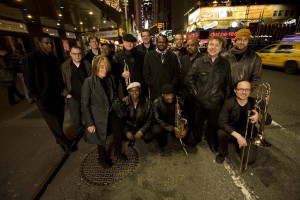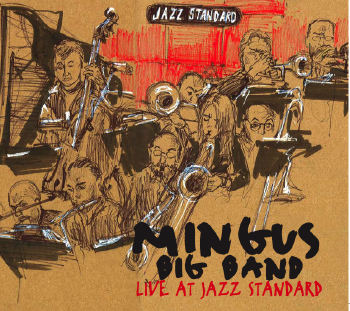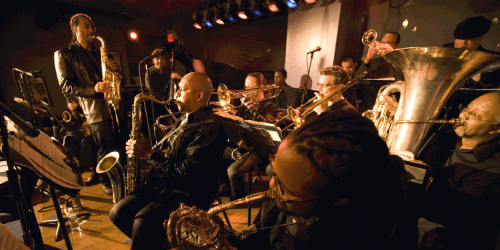The Mingus Big Band is bigger than most big bands because they play the music of Charles Mingus. Of the many words one could use to describe Mingus, (and one has to use many words to adequately describe Mingus) it is big: he was physically imposing and he had feelings, opinions, and musical genius that no ordinary person could possibly contain, much less hope to convey. Most of all, he made big music. His knowledge of and passion for all types of expression is evident in practically every note he wrote over the course of four astonishingly productive decades. The catalog of his recordings is, in many regards, still being fully absorbed and understood. His output was so vast and encompassing it is impossible to summarize or easily encapsulate the scope of his achievement and influence. Suffice it to say, the shadow he cast continues to creep into any conversation about jazz music in the 20th century.
Thanks to the Mingus Big Band, we have the opportunity to keep much of that music alive and screaming in the hear-and-now, while the band’s contemporary interpretations of Mingus’s compositions allows the songs to breathe, mutate and swing their way into a new millennium. Overseen by Charles’s widow Sue Mingus, the band has been performing in New York City since 1991. Almost 20 years later, the Mingus Big Band has staked its claim as an American cultural institution—an extension of Mingus’s repertoire but very much its own entity. This, of course, is a tribute band that does not sound like a typical tribute band. On one hand, they do not play any “safe” covers, which speaks well of their collective abilities; on the other hand, they are playing Mingus compositions, which are so fully realized they effectively self-police misinterpretation. The only way you can mess up a Mingus tune is by having unprepared or unqualified musicians attempting to play it, and that is assuredly not an issue with this band, which comprises some of the finer players on the scene.
Beginning in 2008, the band commenced its association with Jazz Standard (coincidentally named “Best Jazz Club 2008” by New York Magazine). On New Year’s Eve of that year, the band was filmed during their performance and that concert is now available on the new release Mingus Big Band Live at Jazz Standard. Aside from the historic import (the show was broadcast nationwide on NPR) and the festive occasion, this was a special show for another reason. Anticipating the transition into 2009, all of the songs performed are compositions Mingus recorded 50 years prior. 1959 was a special year for jazz music and a crucial one for Charles Mingus. He released his masterpiece, Mingus Ah Um, as well as Mingus Dynasty and recorded Blues And Roots (which was not released that year).
It is remarkable, despite the band’s track record and longevity, how seamlessly they navigate the pieces from ’59—some of which were written for much smaller bands. For the Mingus Dynasty sessions Mingus assembled one of the larger groups he’d worked with to that point; it was not until the next decade that he had consistent opportunities to employ more musicians—albeit not as often as he would have liked. Indeed, one of the more impressive aspects of Mingus’s realization as a composer and leader is how he was able to thrive with whatever he had at a particular point in time. Listening to selections from 1957’s The Clown affords the opportunity to savor—and marvel at—the sounds he was able to conjure out of five musicians (including himself). A barnburner like “Haitian Fight Song” or a swinging tone poem like “Reincarnation of a Lovebird” are, in addition to being bona fide jazz masterworks, case studies of a dedicated artist translating the magic he hears in his mind. There is, then, a sort of reverse alchemy unfolding when the Mingus Big Band performs: if their namesake made big music with minimal resources, this band is obliged to convey the raucous feeling of the originals while integrating some of the instruments the composer might have incorporated, given the chance.
Mingus Big Band Live at Jazz Standard is an almost flawless slice of some of Mingus’s finest work. Anyone familiar (including the faithful and besotted) with the original material should be dutifully impressed with the way they are rendered; for a newcomer who has not had a chance to dive into the tidal wave of all-things-Mingus, this is an excellent gateway. For obvious reasons, the selections from Mingus Dynasty seem most suited for a big band (again, those sessions featured seven or ten players on each track). “Gunslinging Birds”, “New Now Know How” and the show-closing “Song With Orange” (which features a scorching piano solo by David Kikoski) all swing like nobody’s business and the band manages to sound intense and ebullient (one suspects Mingus would approve). Trumpet virtuoso Randy Brecker, who played with Charles in the ‘70s, is typically delightful, and the addition of drummer Jeff “Tain” Watts kicks things up a notch. The band dives into the rootsy blues by way of The Big Easy on a dirge-like deconstruction of “Cryin’ Blues” (arranged by bassist Boris Kozlov, who is in particularly fine form throughout and should always be front-runner as band MVP considering the boots he is obliged to fill): it is impossible (for this writer anyway) to consider anything an improvement on any Mingus original, but this rendition brims with playful fervor that truly does Mingus proud.
The high points include a trio of songs that even a stellar band must cover with care. “Goodbye Pork Pie Hat” is generally regarded as one of the sublime jazz ballads; this rendition includes the vocals Joni Mitchell wrote for her own Mingus tribute (Mingus, from 1979), sung tastefully by Ku-Umba Frank Lacy. “Bird Calls” would frankly overwhelm almost any working band—there is so much going on and the pace is so breakneck throughout it would be easy to imagine even capable musicians tripping all over each other trying to recreate the heat lightning in a box that Mingus & Co. laid down in ’59. Finally, the immaculate “Self-Portrait In Three Colors”, originally a study in expressive restraint, is sped up ever so slightly and manages to actually swing while capturing the full emotional impact of the original.
Speaking with Sue Mingus is like conversing with jazz: she is enervated and completely in the moment, yet also a living conduit to history, a voice of experience and authority. One approaches an opportunity like this with a combination of excitement and attentiveness. She is legendary not only because of her close association with Charles Mingus, but also for the passionate advocacy with which she guards her husband’s legacy. She achieved underground hero status amongst jazz fans when stories spread about her habit of entering record stores all over the world and waltzing out with unpurchased copies of Mingus bootlegs. If confronted she encouraged the shopkeepers to call the cops; they never did, quite aware they had no legal ground to stand on. The title of Sue’s (award-winning) memoir Tonight At Noon references one of her husband’s compositions, and the image it conjures is a miraculous anomaly (or an anomalous miracle). It also invokes the nocturnal hours intrinsic to a working musician’s existence. Of course it is also more than a little autobiographical: Mingus was a contrarian as well as a contradiction, notoriously demanding of those in his employ (particularly those poor piano players), yet protective and loyal (especially to Eric Dolphy and Dannie Richmond—two of his artistic and spiritual soul mates). He could be intimidating and imposing when he had to be, and occasionally when he did not intend to be. He was arguably the only player in history capable of making an upright bass look modest. Most of all he was sensitive and cerebral, and he is easily one of the most important musicians America has produced.
Asked to talk about the band she directs and its new release she is unequivocal. “Charles would be pleased to see these pieces being played fifty years later,” she says. “Obviously the vitality and freshness is not lost. Of course these are great musicians and they are keeping the spirit [of the music] alive.” Sue is understandably reluctant to pick a favorite amongst the Mingus Big Band’s recordings, but she concurs that this latest effort does justice to the originals while stretching out and expanding songs that are so familiar and beloved. “A lot of the band’s success and the positive reception to the music has to do with the passage of time,” she suggests. “Peoples’ ears are growing up to the music; the big band caught on right away … it was the right time to have this band performing this music.”
There is inexorably a bittersweet element to this band’s existence, which is the unavoidable absence of its namesake. There is also the substantial irony that Mingus—despite having larger bands at his disposal in the late ‘60s and throughout the ‘70s—seldom had the ways or means to work with the fuller ensembles he often desired. “Charles would love to have played with bigger bands,” Sue confirms. “Economically it just didn’t make sense; it just wasn’t feasible. But he definitely would have loved a working 14-piece band!”
If there is an aspect of injustice here, it does seem to be a natural progression for Mingus’s works, being performed on a weekly basis by a dream band he never had the chance to handpick. Sue can’t say enough good things about the Mingus Mondays program at Jazz Standard, though she is quick to convey her appreciation for past venues. “We were at Fez [under Time Café in New York City] for 13 years. Every Thursday night—it was like home for us. Unfortunately they closed the music aspect and revamped the restaurant.” After performing at various locations, in late 2008 the band initiated its ongoing residence at Jazz Standard. “This is the closest we’ve been to the feeling of Fez. We love it here and the audience is always receptive. We enjoy having the opportunity to showcase the three different bands.” Sue is referring here to the other two collectives, Mingus Dynasty—a seven-piece band—that tends to be on the road in between gigs and The Mingus Orchestra—a 10-piece band—which features more exotic instruments such as bassoon, harp and clarinet. On any given Monday you can catch one of these outfits in action. “Mingus wrote over 300 compositions, so there is plenty of material to work with and there is always something for everyone.”
Speaking of those compositions, it is indeed refreshing, if overdue, to see Mingus’s name increasingly mentioned when the alpha dogs of jazz are discussed. These days one usually hears “Miles, Monk and Mingus” along with “Coltrane, Bird and Dizzy.” Having lived with Mingus from 1964 until his death in 1979, Sue has watched the slow but steady trajectory of his reception into the pantheon, all these years later. “It’s definitely happening,” she affirms. “People pay more attention and Mingus is entering the mainstream.” Asked to elaborate, she suggests that to a certain extent this acknowledgment was inevitable. “The music is so personal and because of its openness it attracts musicians. People love to play this music, and its tentacles are reaching out. We see it being used more regularly in film and TV and advertisements.” Sue suspects some of the initial challenges in getting Mingus the recognition he deserved was a matter of preconceptions. “People thought the music was unapproachable. Mingus was larger than life and some folks figured his music was too complex or difficult. Now we see kids playing this music!” There is indeed an annual high school competition (directed by Sue) and a quick visit to YouTube illustrates the diversity in age and ethnicity of people performing Mingus’s music.
Sue recalls the performance of Mingus’s posthumous masterwork Epitaph (the title Mingus sardonically chose, certain it would never get performed in his lifetime) in 1989 as a major turning point. The concert, conducted by Gunther Schuller and performed ten years after Mingus’s death, was successful and a double-CD was later issued. “It was difficult going at first,” Sue admits. “But after a few years it was astonishing how easy it seemed.” Everything clicked and the various tribute bands began taking their shows on the road. Over time Mingus gradually began to be fully appreciated as a composer as much as a masterful bass player, and every day more people are getting hit in their souls.
When the topic turns to two recent releases, (Charles Mingus: Music Written for Monterey, 1965 and Charles Mingus Sextet with Eric Dolphy, Cornell 1964) the question must be asked whether or not any additional footage remains in the vaults. Tantalizingly, the answer is affirmative. “There is hours of piano music, actually,” Sue confirms. “Mingus spent most of his time on the piano; that is where he worked out his ideas and how he composed. He used to say that the music was waiting for him on the keys.” Presciently, and thankfully, Sue got in the habit of tape recording the pieces he would improvise and as a result she has “tons of tapes” to work with. Anyone who has heard the somewhat overlooked Mingus Plays Piano understands that these are not just enlightening works in progress; they are fully-formed monologues that function—in addition to being remarkable music—as irrefutable evidence of Mingus’s compositional genius. Sue relates the story of Alvin Ailey choreographing some of the piano sketches for a 60-piece orchestra, and the musicians could not (and initially did not) believe it was all improvised music.
Mingus used to refer to his “workshop” and he would assemble various musicians to flesh out the songs prior to performance or recording. In similar fashion the Mingus Big Band workshops existing Mingus material, but also collaborates to rearrange familiar works. In terms of what we might expect next from the Mingus Big Band, Sue mentions that bassist Boris Kozlov has been hard at work arranging “Meditations for Moses” (from Mingus Plays Piano). While we wait to see how they tackle that, Sue reiterates that the band will almost certainly revisit and rearrange other outlines from Mingus’s piano recordings. Perhaps most exciting, Sue lets it slip that she is working on another book. We can only imagine how many anecdotes and insights we’ve yet to hear, but considering how productive and passionate Mingus was in his music and his life, there is a lot to look forward to. Charles Mingus accomplished many remarkable things; we know now—more than ever—that one of his best decisions was marrying the woman who lived with him and loved him. She still does.



